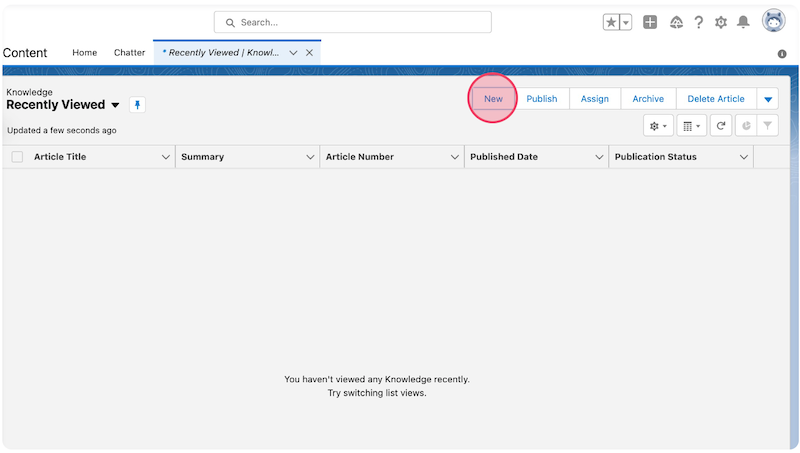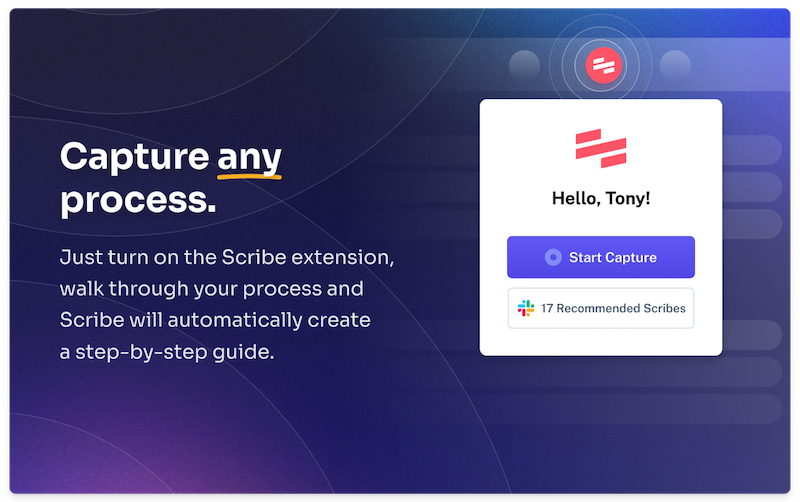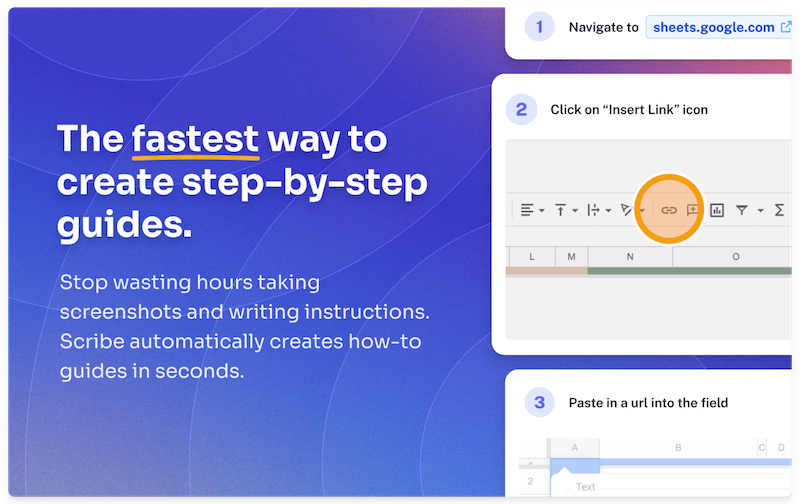Introduction
Jump to...
- What is Salesforce Knowledge?
- What are the benefits of Salesforce Knowledge?
- Salesforce Knowledge features
- How to use Salesforce Knowledge
- Why use Scribe with Salesforce Knowledge?
- Salesforce Knowledge FAQs
Salesforce Knowledge is a powerful tool that allows businesses to create, manage, and share knowledge articles with their employees and customers.
Whether you're new to Salesforce or looking to optimize your knowledge management process, this step-by-step playbook will walk you through how to build a knowledge base.
Playbook: Salesforce Knowledge
- Salesforce Knowledge is a powerful tool for creating, managing and sharing knowledge articles.
- It offers benefits such as improved self-service, increased agent productivity, and reduced support costs.
- Key features include article creation and management, search and discovery, knowledge sharing and analytics.
- Use Scribe with Salesforce Knowledge to create comprehensive visual step-by-step knowledge articles.
- Follow the step-by-step playbook to set up and customize Salesforce Knowledge.
What is Salesforce Knowledge?
Salesforce Knowledge is a knowledge management system that allows organizations to capture, store and share information with their employees, customers and partners. It's a centralized repository of knowledge articles that can be accessed and searched by users to find answers to their questions or to learn more about a specific topic.
Salesforce Knowledge can help businesses of all sizes improve customer service and reduce support costs.
What are the benefits of Salesforce Knowledge?
Salesforce Knowledge offers a number of benefits, including:
- Improved self-service: Salesforce Knowledge makes it easy for customers to find answers to their questions, without having to contact customer support. This can reduce the number of support tickets and improve customer satisfaction.
- Increased agent productivity: Salesforce Knowledge provides agents with a single place to find the information they need to answer customer questions quickly and accurately. This can help improve agent productivity and reduce the average time to resolve support cases.
- Reduced costs: Salesforce Knowledge can help businesses reduce support costs by deflecting support tickets and empowering customers to solve their own problems.
Generate Salesforce Knowledge visual articles and guides ➜
What are the features of Salesforce Knowledge?
With Salesforce Knowledge, you can create and manage a knowledge base of articles, FAQs and other resources that can be used by customers, partners and employees.
Here are some of the key features of Salesforce Knowledge:
- Article creation and management: Salesforce Knowledge provides a user-friendly interface for creating and managing knowledge base articles. Articles can be organized into categories and subcategories and then tagged with keywords to make them easier to find.
- Search and discovery: The search engine allows users to easily find the articles they need. The search engine supports natural language search, so users can search for articles using the same language they would use to ask a question.
- Knowledge sharing: Salesforce Knowledge makes it easy to share knowledge base articles. Articles can be published to the Salesforce customer portal, embedded in websites and other applications, or shared via email.
- Analytics and reporting: Access a variety of analytics and reporting tools that businesses can use to track how their knowledge base is being used. See which articles are being viewed the most, which are leading to case resolution, and which articles need updating.
- Article approvals: You can set up approval workflows for new and updated articles to ensure they are accurate and up-to-date before publication.
- Article version control: Salesforce Knowledge keeps track of all changes made to articles, so you can easily revert to previous versions of articles if needed.
- Knowledge article translations: Translate your knowledge base articles into multiple languages, so you can reach a wider audience and provide support to customers in their native language.
- Knowledge article recommendations: Salesforce Knowledge can recommend relevant knowledge base articles to customers and agents based on the context of their case or interaction.
How to use Salesforce Knowledge
Now that you understand the benefits and features of Salesforce Knowledge, let's dive into the step-by-step playbook on how to use it.

Step 1: Enable Salesforce Knowledge and install Scribe
Before you can start using Salesforce Knowledge, you need to enable it in your Salesforce org. To do this, follow these steps:
- Log in to your Salesforce account.
- Go to Setup by clicking on the gear icon in the top-right corner.
- In the Quick Find box, type "Knowledge Settings" and select it from the search results.
- Click on "Edit" and check the box next to "Enable Salesforce Knowledge."
- Save your changes.
Download Scribe so you can capture and embed visual knowledge base guides for your team. Here's how to get started. ➜

Step 2: Set up data categories
Data categories help organize your knowledge articles and make them easier to find. To set up data categories, follow these steps:
- In Setup, type "Data Categories" in the Quick Find box and select it.
- Click on "New Data Category Group" and give it a name.
- Add individual data categories within the group by clicking on "New Data Category".
- Assign articles to data categories to classify them effectively.
Step 3: Create Knowledge record types
Knowledge record types allow you to customize the fields and layouts for different types of knowledge articles. To create a new Knowledge record type:
- From Setup, in the Quick Find box, enter "Knowledge Record Types".
- Select "Knowledge Record Types".
- Click "New".
- Enter a name and description for the record type.
- Click "Save".
Step 4: Customize your record type page layouts
Once you have created your Knowledge record types, you can customize the page layouts to include the fields and sections that you need. To customize a page layout:
- From Setup, in the Quick Find box, enter "Knowledge Record Types".
- Select "Knowledge Record Types."
- Click the name of the record type that you want to customize.
- Click "Edit Layout".
- Make the desired changes to the page layout, and then click "Save."
Step 5: Set access for Knowledge users
You can control who has access to create, view and edit Knowledge articles by setting user permissions. To set user permissions:
- From Setup, in the Quick Find box, enter "Users," and then select "Users."
- Click the name of the user whose permissions you want to set.
- Click "Edit."
- Under "User Permissions," select the Knowledge permissions that you want the user to have.
- Click "Save. "
Step 6: Create a Lightning Knowledge portal
A Lightning Knowledge portal is a self-service portal where customers and partners can access your knowledge base. To create a Lightning Knowledge portal:
- From Setup, in the Quick Find box, enter "Lightning Knowledge."
- Select the Lightning Knowledge Settings.
- Click "New."
- Enter a name and description for the portal.
- Select the Knowledge record types that you want to include in the portal.
- Click "Save."
Step 7: Create Knowledge articles
Now it's time to start creating your knowledge articles. Here's how:
- Go to the App Launcher and select "Knowledge."
- Click on "New" to create a new article.
- Fill in the article details, such as title, summary, and article type.
- Use the rich text editor to format your article and add Scribes, images, videos or links.
- Assign data categories to the article to improve searchability.
- Save the article.
Step 8: Add guides to your articles
Use Scribe with Salesforce Knowledge to create and embed comprehensive visual step-by-step knowledge articles.

To get started, install Scribe and follow the steps below:
1. Navigate to the desired process you want to document. Click the Scribe icon in your Chrome toolbar to start.
2. Click the "Start Capture" button and walk through the process you want to document. Scribe automatically captures screenshots and text based on your actions.
3. Click the "Stop Capturing" button. In a few seconds, Scribe will generate a detailed, step-by-step guide.
4. Review the guide, making sure that you've included all relevant information. You can edit to add steps or clarify information if you've missed anything.
5. Ask the AI to add titles, descriptions, additional context, alerts, helpful tips, and more to customize your guide.
6. When your guide is finished, click "Share" and then "Export".
7. Click the "Export" button next to "Export as HTML".
8. Navigate to Salesforce Knowledge.
9. Click "New".
10. Click on the rich text field in the article.
11. Click "Copy to Clipboard."
12. Click into the body of the article and then paste.
13. Fill out the other required fields.
14. Click "Save".
15. Your Scribe has now been added to the body of the Salesforce Knowledge article!
Step 9: Publish and share Knowledge articles
Once your knowledge articles are created, you can publish and share them with your team or customers. Follow these steps:
- Open the article you want to publish.
- Click on "Publish" and choose the appropriate visibility settings.
- If necessary, set up article translations for multilingual support.
- Share the article by sending the link or embedding it in your website or customer portal.
Step 10: Analyze and improve Knowledge usage
Use the analytics and reporting features to help you measure the effectiveness of your knowledge base:
- In Setup, type "Knowledge Settings" in the Quick Find box and select it.
- Enable article ratings and comments to gather user feedback.
- Use the "Knowledge Article Reports" to track article views, ratings and comments.
- Identify popular articles and areas for improvement based on user feedback.
- Update and enhance your knowledge base as needed.
Why use Scribe with Salesforce Knowledge?
Whether you're gathering information for knowledge articles, documenting instructions or creating an FAQ repository, Scribe builds and stores your process docs in seconds.
Here are just a few of the benefits of using Scribe and Salesforce Knowledge:
Create more informative and engaging Knowledge articles
With Scribe, you can create Knowledge articles that include screenshots, screen recordings and step-by-step instructions in seconds.
Easily keep your Knowledge articles up-to-date
As your products and services change, you can quickly and easily update your Knowledge articles, ensuring your knowledge base always has accurate and up-to-date information.
Reduce the time it takes to create and update Knowledge articles
With Scribe, you can document your processes 15x faster and automate the process of creating and updating Knowledge articles. This is especially important if you have a large number of Knowledge articles.
Improve the user experience
Scribe makes it easy for users to users understand your Knowledge articles. With Scribe Pages, you can compile and save videos and other materials (such as screenshots, infographics and links) to create articles, creating more comprehensive educational resources.
"I used to have to gather and assemble screenshots, generate instructions, and spend hours putting all those elements together in a usable format. Scribe does in 5 minutes what would have taken me more than an hour in the past." — Haggerty Museum of Art
{{banner-short-v2="/banner-ads"}}
Salesforce Knowledge FAQs
How do I access Salesforce Knowledge?
To access Salesforce Knowledge, you can follow these steps:
- Log in to your Salesforce account.
- Navigate to the App Launcher by clicking on the grid icon in the top-left corner.
- Search for "Knowledge" in the search bar and select "Knowledge" from the results.
- This will take you to the Knowledge homepage, where you can access articles, categories and other knowledge-related features.
- You can use the search bar to find specific articles or browse through categories to find relevant information.
- You can also create, edit and manage knowledge articles from this interface.
How do you implement Knowledge in Salesforce?
Implementing knowledge in Salesforce involves using the platform's Knowledge feature to create a centralized repository of information. You can do this by:
- Creating knowledge articles with relevant information.
- Including FAQs, troubleshooting guides and best practices.
- Organizing articles into categories.
- Making articles accessible through a knowledge base.
- Leveraging Salesforce's AI-powered search for quick and easy information retrieval.
How do I configure fields, layouts and record types?
When configuring fields, layouts, and record types in Salesforce, follow these steps:
- Navigate to the Object Manager and search for the Knowledge object.
- Create a new page layout by selecting an existing one to copy or starting from a blank page.
- Add relevant fields, lists and lightning actions to the layout as needed.
- Create a record type to assign to users, selecting the appropriate profiles and page layout.
- Choose to apply one layout to all profiles or set different layouts for each profile.
- Use the Salesforce Lightning Knowledge Migration Assistant for assistance, but be prepared for manual work.
- Review all necessary steps and allocate enough time before finalizing the timeline and Go Live date.
How do I search and access Salesforce Knowledge articles?
Salesforce Knowledge provides robust search capabilities to help users find the information they need quickly. Here's how to search and access knowledge articles:
- In the App Launcher, select "Knowledge."
- Use the search bar to enter keywords related to your query.
- Refine your search using filters like data categories, article types, or language.
- Click on the article title to view its details and content.
- Use the "Related Articles" section to explore additional relevant articles.
Conclusion
Empower your employees, partners and customers with easy access to valuable information, improving productivity and customer satisfaction.
By following this step-by-step playbook, you can effectively use Scribe and Salesforce Knowledge to create, manage and share knowledge articles within your organization. Sign up for Scribe today and get started!







